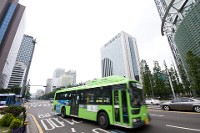Pathways towards a Low Carbon Green Korea
Overview
IIASA and research institutes in South Korea are collaborating on a new project to provide scientific analysis to underlie new policies for green growth and sustainable economy, with the goal of transforming South Korea to a low carbon green economy by 2050. The new project will bring together the Greenhouse Gas Inventory and Research Center of Korea (GIR) and the Korea Forest Research Institute (KFRI), along with three IIASA research programs, the Mitigation of Air Pollution and Greenhouse Gas (MAG) program, the Energy (ENE) program, and the Ecosystems Services and Management (ESM) program. While the project will provide specific information for Korea’s future, it will also serve as a test case for a new brand of greenhouse gas (GHG) mitigation modeling that extends detailed and multi-faceted analysis far enough into the future to be useful for planning.
A new greenhouse gas mitigation analysis model
Currently, detailed national models of energy usage and transition only extend for 10 to 20 years. Longer term models, used as scientific tools at the global level, are currently not detailed enough to help guide decision-making of national policy makers.
The main output of the Green Korea project will be a new modeling tool with a number of innovative features that provide more detailed information, a variety of scenarios, and longer timelines. Inter alia, research will attempt to address the following features:
- A multi-sectoral systems focus: Eventually, the new model will bring together measures of all relevant GHG emitting sectors and activities, including energy, agriculture, passenger and freight transport, waste generation, forestry, land use, etc.. It will address supply and demand side.
- Focus on consumers’ preference on the demand side: Special emphasis will be devoted to improve the understanding of consumer’s demand preferences for housing, mobility and human diet, and the requirements of low-carbon pathways for changed consumer preferences.
- Agent-based approach: In the new model, each sector will be represented by a module that simulates decisions of individual agents, reflecting utility, planning horizons, profit expectations and available information of typical agents in the sector.
- Equilibrium based instead of cost-optimization with perfect foresight: Instead of a cost optimization from a single social planner’s perspective with perfect foresight, the overall transition pathway will be generated from market equilibrium solutions that reflect the distribution of decision making among agents. The agents make decisions individually about their activities based on their expected market situation.
- Systems perspective: While the model will address transition pathways toward low carbon economies, it will quantify synergies and trade-offs with other policy priorities, such as economic development, energy security, local air quality, human health, etc.
- Identifying critical constraints instead of single optimal pathways: Instead of single pathways that emerge as optimal for a narrow objective function (e.g., minimization of net present value of costs from a social planners perspective), the new tool aims at the identification of constraints (e.g., in consumer preferences, technology penetration, investment needs, etc.) that are critical for a successful transition. Furthermore, emphasis will be on robust ranges of near-term decisions that enable or prohibit achievement of the long-term targets.
RESEARCH PARTNERS


